Baggage Handling eTool

Baggage Handling » Make-up Room

Agents who work in the baggage make-up room spend long hours on their feet. They must move baggage from conveyors to carts and baggage containers for transport to the plane. Conditions in the make-up room can be particularly stressful during peak times when baggage flow rates are at their highest. Controls can help reduce or eliminate make-up room injuries when using the following baggage sorting systems:
See also hazards associated with baggage carts or containers.
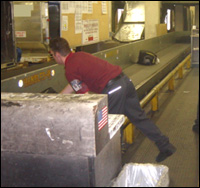
Potential Hazards
-
Repetitively lifting baggage from the conveyor while assuming awkward body postures and extended reaches (Figure 1)
-
Twisting the torso and keeping the feet stationary when lifting baggage between the conveyor and the cart
-
Lifting heavy baggage
-
Bending over and reaching farther for bags in order to work around curbs, railings, and bollards
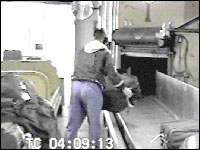
Possible Solutions
-
Educate agents about proper lifting techniques to increase awareness of good work practices.
-
Perform stretching exercises that help loosen and relax the muscles and joints.
-
Use both hands to handle baggage (Figure 2) and avoid lifting baggage by the handle to minimize lifting from awkward postures.
-
Minimize twisting while lifting by
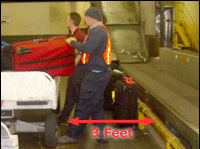
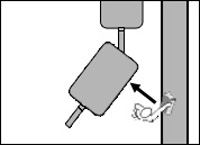
- Keeping carts approximately 3 feet from belt (Figure 3), and
-
Parking the cart at an angle when space allows. (Figure 4)
-
Load heavy bags as close to the cart opening as possible to minimize force associated with extended reaches
-
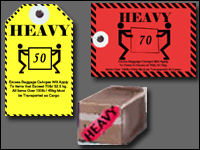
Use heavy baggage tags to create awareness of actual bag weights. (Figure 5)
-
Raise the height of conveyors (29 to 33 inches high) to reduce bending and lifting
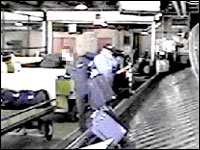
Potential Hazards
-
Reaching for baggage that has been double stacked
-
Removing baggage that is jammed between the carousel lip and other baggage
-
Twisting the torso and keeping the feet stationary when moving baggage between the conveyor and the cart
-
Lifting heavy baggage
-
Reaching farther for bags to work around curbs, railings, and bollards

Possible Solutions
-
Educate agents about proper lifting techniques to increase awareness of good work practices.
-
Perform stretching exercises that help loosen and relax the muscles and joints.
-
Keep bags from piling up on the lip of slope plate systems to avoid having to exert excessive force to free the baggage.
-
Slide baggage close to you before lifting to avoid lifting with an extended reach.
-
Minimize the distance between the belts and the railings/bollards to reduce extended reaches.
-
Raise the carousel lip to minimize bending (preferably between 29 and 33 inches).
-
Minimize the height of the front lip of the carousel to prevent handles from getting caught and to decrease the distance baggage is lifted over the lip.
The double deck pier system should not be installed in new or renovated make-up rooms. This section is to provide employees with information on how to work with their current baggage handling system.

Potential Hazards
-
Repeated lifting of heavy bags from high locations, such as the top belt of a double deck pier system.
-
Repeated lifting with little recovery time between exertions because belt speeds are set too fast when there is a high flow of bags.
-
Extended reaching for a bag located at the back of a wide top belt (Figure 8).
-
Bending and reaching under top belt for bags on the bottom belt.
-
Protruding objects from belt sides, such as "eyelets" through which emergency stop cords run.
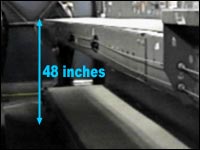
Possible Solutions
-
Educate agents about proper lifting techniques to increase awareness of good work practices.
-
Perform stretching exercises that help loosen and relax the muscles and joints.
-
Use top belts that are 30 inches wide or less to reduce extended reaches.
-
Limit the heights of top belts to under 50 inches (preferably 48 inches) and raise bottom belts as much as possible to minimize bending when retrieving baggage, being careful not to create a "head-strike" risk. (Figure 9)
-
Using double deck pier belt systems may lead to more hazards than a single pier, flat, or sloped carousel belt system. If present investigate lowering upper tier to suggested height recommendations to reduce hazards. (Figure 9)
-
Minimize distance between conveyors and railings/bollards to reduce reach distances.
-
Have engineers "meter" the speed of the belt based on the type of baggage being unloaded so the agent is not unloading baggage at a rate that increases his/her chances of being injured.
-
Minimize protrusions from belt sides to avoid injury to agents.
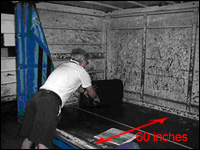
Potential Hazards
- When loading or unloading a cart, avoid:
- Reaching away from the body or above shoulder height (Figure 10)
- Handling heavy bags
- Lifting bags over front rails or guards
-
Twisting the body during baggage transfer
-
Manually repositioning loaded carts.
-
Opening and closing curtains on carts.
Possible Solutions
-
Educate agents about proper lifting techniques to increase awareness of good work practices.
-

Perform stretching exercises that help loosen and relax the muscles and joints.
-
If space allows, park carts on an angle to minimize twisting motions. (Figure 11)
-
If required to reach, grab the bag by the handle and slide it to the front of the cart; lifting baggage with the arms extended increases the risk of back and shoulder injury.
- Conduct preventative maintenance inspections, such as
- Proper tire inflation
- Lubrication for curtains
-
Brake tests
-

Avoid stacking bags above shoulder height in open carts to prevent overhead reaches that can strain the neck, shoulders, and back.
-
Move carts using powered equipment whenever possible.
-
If carts must be manually positioned, push them instead of pulling them and get help from at least one other person.

